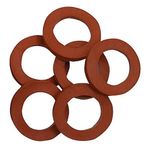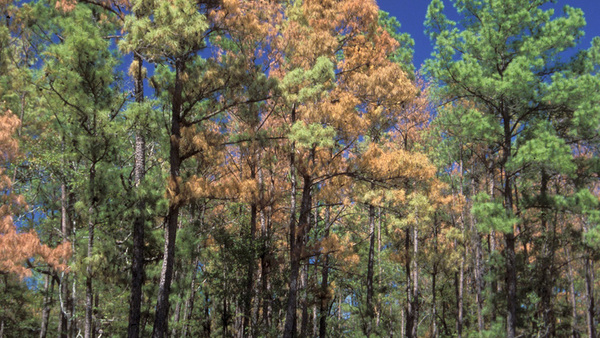
Although they resemble miniature slugs, rose slugs are not true slugs at all. They’re the larval stage of the European sawfly (Endelomyia aethiops), a small, rather innocent-looking flying insect. European rose slugs, the most commonly found sawfly in my area of Northern California, are yellow-green in color and can grow up to ¾ inch long. Bristly rose slugs (Cladius difformis) can also be found in Northern California and are quite similar, but—you guessed it—slightly bristly-looking in appearance. The other difference is that bristly rose slugs feed on the underside of the leaves, whereas European rose slugs eat the upper layer of the leaves. Both cause a lot of damage to a rose garden in May and June if left unchecked.

Damage
The sawfly larva feeds on the outermost surfaces of the rose leaf, removing the soft, upper, green layer (or lower layer), leaving behind a papery, chlorophyll-free leaf with a translucent interior. A heavy infestation of these pests results in brown, almost scorched-looking foliage. This stresses the plants and leaves them vulnerable to disease and further pest problems. It also affects foliage and bloom production. Lighter infestations are less harmful but can lead to patches of unsightly foliage, which mars the beauty of the rose plant and ruins the gardener’s full enjoyment of the rose garden.
Rose-slug life cycle
Adult sawflies emerge in spring to lay their eggs on a rose’s leaves, with the larvae—the rose slugs—appearing several weeks later. In my Northern California garden, I typically begin to notice evidence of rose-slug damage toward the end of April. These soft-bodied pests feed on the foliage for about a month and then drop into the soil to pupate. If that generation of rose slugs isn’t dealt with appropriately, each subsequent infestation will increase in severity.
Options for treatment
Handpick. Diligent garden sanitation is vital to prevent an infestation. Beginning in April, inspect the foliage of your roses for signs of infestation, checking both upper and lower surfaces of the leaves. For minor infestations, pick off and squash the rose slugs, and remove the affected leaves. Your garden hose can be a useful control method. To kill the soft-bodied pests, simply spray them off the leaves using a strong blast of water. Continue checking your roses regularly throughout spring and summer to ensure healthy plants and abundant, beautiful blooms all season long.

Start spraying. If the infestation is a heavier one, it might be time to use an organic insecticide. Horticultural oil, insecticidal soaps, and products containing spinosad are all useful when a heavy infestation of rose slugs presents itself. Apply the products only when larvae are actually present, making sure you coat both sides of the leaves for maximum effectiveness. As always, read the label directions fully and follow them to the letter before applying anything, even organic products. Note: Bacillus thuringiensis (Bt), a commonly used biological insecticide that controls infestations of many caterpillars, is NOT effective against rose slugs.
Support natural predators. You can support the natural enemies of these pests by using organic gardening practices and, most importantly, by avoiding broad-spectrum pesticide usage in your garden. There are many insects you don’t want to kill that will actually eat rose slugs. Parasitic wasps, predaceous beetles, and insect-eating birds can all help reduce both adult and larval sawfly populations.

Rehabilitating damaged roses
Some roses in my garden are more susceptible than others to the ravages of rose slugs (leathery-leaved roses appear to be most resistant), and if I don’t stay on top of it, the foliage can become completely decimated, which stresses the plants badly. When this happens, I prune the affected rose heavily, stripping off the diseased-looking foliage and tossing all the clippings and leaves in the green waste bin. (Just be sure there are no rose-slug larvae on the foliage if composting.) I then feed my rose with an organic, well-balanced fertilizer and mulch it with a 3- to 4-inch layer of compost. This goes a long way toward restoring the affected rose bush’s health and always leads to a full recovery and subsequent blooms!
And make sure to proactively prune and fertilize your roses in winter so that plants are less stressed come spring.
—Fionuala Campion is the owner and manager of Cottage Gardens of Petaluma in Petaluma, California.
Fine Gardening Recommended Products

Pruning Simplified: A Step-by-Step Guide to 50 Popular Trees and Shrubs
Fine Gardening receives a commission for items purchased through links on this site, including Amazon Associates and other affiliate advertising programs.

Gilmore Rubber Hose Washer 10pk
Fine Gardening receives a commission for items purchased through links on this site, including Amazon Associates and other affiliate advertising programs.
- Clip of 10

ARS Telescoping Long Reach Pruner
Fine Gardening receives a commission for items purchased through links on this site, including Amazon Associates and other affiliate advertising programs.



















Comments
Very nice I really love the information and your blog is very good. I really love reading about Plants. I suggest visiting this website visit their site right here IELTS Classes In Chandigarh they have different types of services and they are very good at every single one of them.
Log in or create an account to post a comment.
Sign up Log in